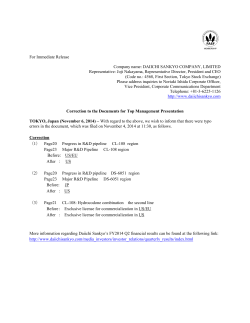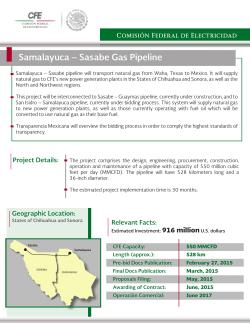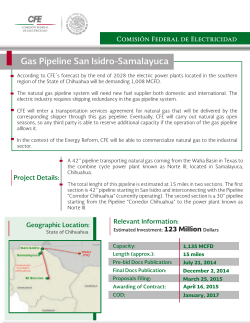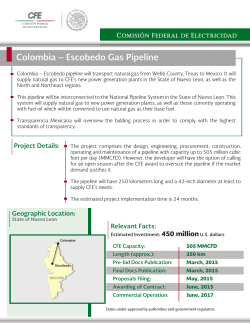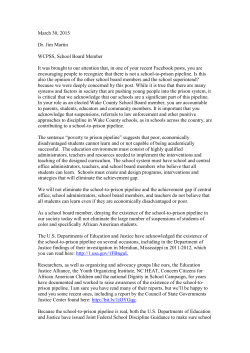
Tassel 5.0 Pipeline
TASSEL 5.0 Pipeline Command Line Interface: Guide to using Tassel Pipeline Terry Casstevens ( tmc46@cornell.edu ) Institute for Genomic Diversity, Cornell University, Ithaca, NY 148532703 June 4, 2015 Prerequisites Source Code Install Execute Increasing Heap Size Setting Logging to Debug or Standard (With optional filename) Examples Examples (XML Configuration Files) Usage Pipeline Controls Data Filter Analysis Results Prerequisites ● Java JDK 8.0 or later ( http://java.sun.com/javase/downloads/index.jsp ). Source Code git clone https://bitbucket.org/tasseladmin/tassel5source.git Install git clone https://bitbucket.org/tasseladmin/tassel5standalone.git OR https://bitbucket.org/tasseladmin/tassel5standalone/downloads (Click on “Tags”) Execute On Windows, use run_pipeline.bat to execute the pipeline. In UNIX, use run_pipeline.pl to execute the pipeline. If you are using a Bash Shell on Windows, you may need to change the following line to use a ; instead of a :. my $CP = join(":", @fl); 1 To launch the Tassel GUI that automatically executes a pipeline, use start_tassel.bat or start_tassel.pl instead of run_pipeline.bat or run_pipeline.pl respectively. These scripts have a $top variable that can be changed to the absolute path of your installation. That way, you can execute them any directory. Increasing Heap Size To modify the initial or maximum heap size available to the Tassel Pipeline, either edit run_pipeline.pl or specify values via the command line. ./run_pipeline.pl Xms512m Xmx10g fork1 ... Setting Logging to Debug or Standard (With optional filename) ./run_pipeline.pl debug [<filename>] … ./run_pipeline.pl log [<filename>] … Examples ./run_pipeline.pl fork1 h chr1_5000sites.txt ld ldd png o chr1_5000sites_ld.png runfork1 ./run_pipeline.pl fork1 h chr1_5000sites.txt ld ldd png o chr1_5000sites_ld.png runfork1 ./run_pipeline.pl fork1 … fork2 … combine3 input1 input2 … fork4 <flag> input3 runfork1 runfork2 Examples (XML Configuration Files) This command runs the Tassel Pipeline according to the specified configuration file... Configuration files are standard XML notation. The tags are the same as the below documented flags although no beginning dash is used. See the example_pipelines directory for some common XML configurations. ./run_pipeline.pl configFile config.xml This command creates the XML configuration file from the original command line flags. Simply insert the createXML and filename at the beginning. Only the XML is created. It does not run the pipeline... ./run_pipeline.pl createXML config.xml fork1 ... This command translates the specified XML configuration file back into the original command line flags... It does not run the pipeline... ./run_pipeline.pl translateXML config.xml 2 Usage Pipeline Controls fork<id> runfork<id> input<id> inputOnce<id> combine<id> 3 This flag identifies the start of a pipeline segment that should be executed sequentially. <id> can be numbers or characters (no spaces). No space between fork and <id> either. Other flags can reference the <id>. This flag identifies a pipeline segment to execute. This will usually be the last argument. This explicitly executes the identified pipeline segment. This should not be used to execute pipeline segments that receive input from other pipeline segments. Those will start automatically when it receives the input. This specifies a pipeline segment as input to the plugin prior to this flag. That plugin must be in the current pipeline segment. Multiple of these can be specified after plugins that accept multiple inputs. ./run_pipeline.pl fork1 h genotype.hmp.txt fork2 r phenotype.txt combine3 input1 input2 intersect runfork1 runfork2 ./run_pipeline.pl fork1 h genotype.hmp.txt fork2 includeTaxaInFile taxaList1.txt input1 export file1 fork3 includeTaxaInFile taxaList2.txt input1 export file2 runfork1 This specifies a pipeline segment as a onetime input to a combine. As such, this flag should follow combine. After the combine has received data from this input, it will use it for every iteration. Whereas combine waits for data specified by input each iteration. Multiple of these can be specified. This flag starts a new pipeline segment with a CombineDataSetsPlugin at the beginning. The CombineDataSetsPlugin is used to combine data sets from multiple pipeline segments. Follow this flag with input<id> and/or inputOnce<id> flags to specify which pipeline segments should be combined. Data t <trait file> s <PHYLIP file> r <phenotype file> k <kinship file> q <population structure file> h <hapmap file> h5 <HDF5 file> plink ped <ped filename> map <map filename> fasta <filename> table vcf <filename> importGuess <filename> hdf5Schema <hdf5 filename> If the filename to be imported begins with “http”, it will be treated as an URL. Loads trait file as numerical data. Loads PHYLIP file. Same at t Loads kinship file as square matrix. Loads population structure file as numerical data. Loads hapmap file (.hmp.txt or .hmp.txt.gz) Loads HDF5 Alignment file (.hmp.h5). Loads Plink format given ped and map files. Loads FASTA file. Loads a Table (i.e. exported from LD, MLM). Loads VCF file. Uses Tassel Guess function to load file. This inspects the HDF5 file for it’s internal structure / schema. ./run_pipeline hdf5Schema file.h5 export schema.txt projection <filename> ./run_pipeline.pl vcf file.vcf projection file.pa export output.hmp.txt convertTOPMtoHDF5 This converts TOPM file into a HDF5 formated <TOPM filename> TOPM file. New files extension will be .topm.h5. ./run_pipeline.pl convertTOPMtoHDF5 file.topm.bin retainRareAlleles Sets the preference whether to retain rare < true | false> alleles. Notice this has no meaning for Nucleotide data. Only data that has more than 14 states at a given site (not including Unknown) are affected. If true, states more rare than the first 14 by frequecency are changed to Rare (Z). If false, they are changed to Unknown (N). union This joins (union) input datasets based taxa. This should follow a combine specification. 4 intersect This joins (intersect) input datasets based taxa. This should follow a combine specification. separate This separates an input into its components if <chromosomes…> possible. For example, alignments separated by chromosome (locus). For alignments, optionally specify list of chromosomes (separated by commas and no spaces) to separate. Specifying nothing returns all chromosomes. Example: run_pipeline.pl fork1 h file.hmp.txt separate 3,6 export runfork1 homozygous This converts any heterozygous values to unknown. ./run_pipeline.pl h file.hmp.txt homozygous export mergeGenotypeTables Merges multiple Alignments regardless of taxa or site name overlap. Undefined taxa / sites are set to UNKNOWN. Duplicate taxon / site set to last Alignment processed. Example: run_pipeline.pl fork1 h file1.hmp.txt fork2 h file2.hmp.txt combine3 input1 input2 mergeGenotypeTables export files_merged.hmp.txt runfork1 runfork2 mergeAlignmentsSameSite Merges Alignments assuming all sites are the s input <files> output same in all Hapmap files. Input files separated <filename> by commas without spaces. The resulting file may have incorrect major/minor alleles, strand, center, etc. It uses values from first specified input file. Checks that Site Name, Chromosome, and Physical Position match for each site. Example: run_pipeline.pl fork1 mergeAlignmentsSameSites input file1.hmp.txt,file2.hmp.txt output temp runfork1 export Exports input dataset to specified filename(s). <filename1,filename2,… If no exportType follows this parameter, the > exported format will be determined by the type of input (i.e. Genotype Tables will default to Hapmap format, Distance Matrix with default to SqrMatrix). Other exportable datasets only have one format option. Therefore, there is no need to specify exportType. Specify none, one, or multiple filenames matching the number of input data sets. If no filenames, the files will be named the same as the input data sets. If only one specified for multiple data sets, a count starting with 1 will be added to each resulting 5 exportType <type> exportIncludeAnno true | false includeTaxa <taxon1,taxon2,…> includeTaxaInFile <filename> excludeTaxa <taxon1,taxon2,…> excludeTaxaInFile <filename> includeSiteNames <siteName1,siteName2,…
> includeSiteNamesInFil
e <filename> excludeSiteNames <taxon1,taxon2,…> excludeSiteNamesInFil
e <filename> excludeLastTrait 6 file. If multiple filenames (separated with commas but no spaces), there should be one for each input. When exporting Hapmap files, if the extension is .hmp.txt.gz, the file will be gzipped. Defines format that previously specified export should use. Type can be Hapmap, HapmapDiploid, HDF5, VCF, Plink, Flapjack, Phylip_Seq, Phylip_Inter, Text, ReferenceProbablity, SqrMatrix, SqrMatrixRaw (for MultiBLUP), SqrMatrixBin (for MultiBLUP). Indicates whether to include annotations in exported file. Filters input alignment to only include specified taxa. The taxa should be separated with commas and no spaces. Filters input alignment to only include taxa specified in file. The taxa cannot have spaces. Individual taxa should be separated by white space. Filters input alignment to exclude specified taxa. The taxa should be separated with commas and no spaces. Filters input alignment to exclude taxa specified in file. The taxa cannot have spaces. Individual taxa should be separated by white space. Filters input alignment to only include specified site names. The site names should be separated with commas and no spaces. Filters input alignment to only include site names specified in file. The site names cannot have spaces. Individual site names should be separated by white space. Filters input alignment to exclude specified site names. The site names should be separated with commas and no spaces. Filters input alignment to exclude site names specified in file. The site names cannot have spaces. Individual site names should be separated by white space. This removes last column of Phenotype data. For example… Can be used to remove last column of population structure for use with MLM or GLM. subsetSites <num> subsetTaxa <num> step numericalGenoTransfor
m <type> newCoordinates <map filename> synonymizer Filter filterAlign filterAlignMinCount <num> filterAlignMinFreq <num> filterAlignMaxFreq filterAlignStart <num> filterAlignEnd <num> 7 This filters an alignment to include a random subset of sites. If <num> is >=1, it specifies the total number of sites to keep. If it is a decimal, it specifies the fraction of sites to keep. Adding the flag "step" immediately after <num> tells the plugin to space the selected sites evenly instead of randomly. This filters an alignment to include a random subset of taxa. If <num> is >=1, it specifies the total number of taxa to keep. If it is a decimal, it specifies the fraction of taxa to keep. Adding flag "step" immediately after <num> tells the plugin to space the selected taxa evenly instead of randomly. This tells the previously specified subsetTaxa or subsetSites plugin to select sites/taxa evenly across the alignment instead of randomly. https://bitbucket.org/tasseladmin/tassel5sourc
e/wiki/UserManual/NumericalGenotype/NumericalGen
otype ./run_pipeline.pl h mdp_genotype.hmp.txt NumericalGenotypePlugin endPlugin export output exportType ReferenceProbablity This converts alignment to new coordinates specified in given map file. Runs the Synonymizer using the input dataset. Filters an alignment by sites. Specifies the minimum count (default: 1) for the previously specified filterAlign. Specifies the minimum frequency (default: 0.0) for the previously specified filterAlign. Specifies the maximum frequency (default 1.0) for the previously specified filterAlign. Specifies the starting site index (default value: 0) for the previously specified filterAlign. Specifies the end site index (default value: last site in alignment) for the previously specified filterAlign. filterAlignLocus <name> filterAlignStartPos <num> filterAlignEndPos <num> filterAlignExtInd filterAlignRemMinor filterAlignSliding filterAlignHapLen <num> filterAlignStepLen <num> Analysis glm glmOutputFile <filename> glmMaxP <number> glmPermutations <number> mlm mlmVarCompEst <method> mlmCompressionLevel <level> 8 Specifies the Locus to be used with the starting and ending physical positions if defined. Defaults to first Locus in the Alignment. Specifies the starting physical position (default is first site) for the previously specified filterAlign. Specifies the end physical position (default is last site) for the previously specified filterAlign. Indicates that the last specified filterAlign should extract indels. This is not done by default. Indicates that the last specified filterAlign should remove minor SNP states. This is not done by default. Indicates that the last specified filterAlign should use sliding windows. This in not done by default. Specifies the haplotype length (default value: 3) if using sliding windows. Specifies the step length (default value: 3) if using sliding windows. GLM Flags are deprecated… Please use run_pipeline.pl FixedEffectLMPlugin This takes a Phenotype dataset as input that is usually the intersection of sequence data, trait data, and population structure (optional). This sends GLM results to specified filename. This restricts the output file to entries with P values no larger than number specified. This sets the number of permutations. Default is to not do run permutations. This takes a Phenotype dataset as input (usually the intersection of sequence data, trait data, and population structure (optional)) and a Kinship matrix. Defines the Variance Component Estimation for the previously specified mlm. Method can be P3D (default) or EachMarker. Defines the Compression Level for the previously specified mlm. Level can be Optimum (default), Custom, or None. mlmCustomCompression <number> mlmOutputFile <filename> mlmMaxP <number> This specifies the compression when compression level is Custom. Default value is 1.0. This sends MLM results to specified filename. This restricts the output file to entries with P values no larger than number specified. diversity Creates a Diversity Analysis step that uses an Alignment as input diversityStartBase This sets start base for the previously <number> specified diversity. Default is 0. diversityEndBase This sets end base for the previously specified <number> diversity. Default is last site. diversitySlidingWin This uses sliding window analysis for the previously specified diversity. diversitySlidingWinStep This sets the sliding window step size for the <number> previously specified diversity. Default is 100. diversitySlidingWinSize This sets the sliding window size for the <number> previously specified diversity. Default is 500. ld Creates LinkageDisequilibriumPlugin. Uses Alignment from previous step to analysis linkage disequilibrium. ldPermNum <number> This sets permutation number for the previously specified ld. Default is 1000. ldRapidAnalysis true Sets whether to use rapid analysis for the | false previously specified ld. Default is true. ldWinSize <number> Sets the window size for the previously specified ld. Default is 50. ldType <type> Sets the LD type for the previously specified ld. Options are All, SlidingWindow (Default), and SiteByAll. ldTestSite <number> Sets the test site for when LD type is set to SiteByAll. ldHetTreatment <type> Sets the LD Heterzygous Treatment Method. Type can be Haplotype (For Inbred Lines), Homozygous (Default Uses only homozygous site heterozygotes set to missing), or Genotype (Not Implemented Yet). ck Calculates Kinship from Marker Data. Deprecated: Please use ./run_pipeline.pl KinshipPlugin tree <clustering This creates a tree using given clustering method> method: Neighbor (default) or UPGMA. When 9 exporting, use exportType Text to get text version. treeSaveDistance true This saves the distance matrix of a tree. | false Default is true. distanceMatrix Calculate the distance matrix of given Alignment. distMatrixRanges Calculates genetic distances for given taxon in specified physical position ranges. distMatrixRangesLocus Locus that specified physical positions <locus> corresponds. distMatrixRangesTaxon Taxon of interest. <taxon> distMatrixRangesPos Specified physical positions that define ranges. <pos1,pos2,pos3,…> A comma should separate each one with no spaces. distMatrixRangesPosFile File with list of physical positions that define <filename> ranges. Individual positions should be separated by white space. gs Predicts phenotypes using ridge regression for genomic selection. genotypeSummary This generates summaries for alignment datasets. <types> Types should be a commaseparated list (with no spaces) of the following (overall, site, taxa, all). Example genotypeSummary overall,site Results td_csv <filename> td_tab <filename> td_gui ldd <output type> ldplotsize <num> 10 Writes (comma delimited) TableReport from previous plugin in current pipeline to specified filename. Writes (tab delimited) TableReport from previous plugin in current pipeline to specified filename. Displays TableReport from previous plugin in current pipeline in GUI. Creates LinkageDiseqDisplayPlugin. If output type is gui, this graphically displays results from a LinkageDisequilibriumPlugin. If output type is png, gif, bmp, jpg, or svg, then an image of that type is written to the output file specified with o. Optionally specify LD plot size. Example: 1000 will produce a 1000 x 1000 plot. Default: 500. ldplotlabels true | false o <output file> 11 This should follow the ldd flag within the current pipeline segment. Optionally specify whether to show the LD Plot labels. DEFAULT: true. This should follow the ldd flag within the current pipeline segment. This should follow the ldd flag within the current pipeline segment.
© Copyright 2025
